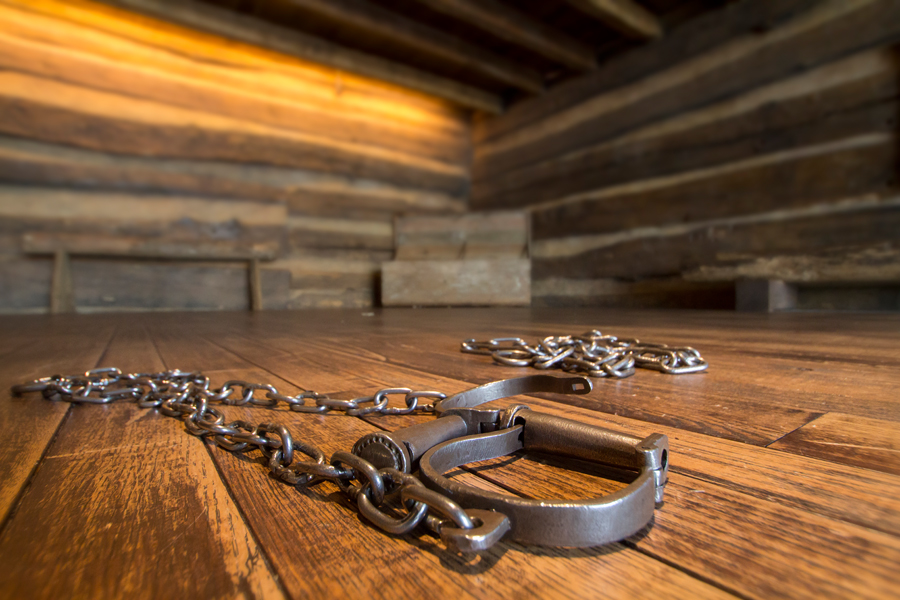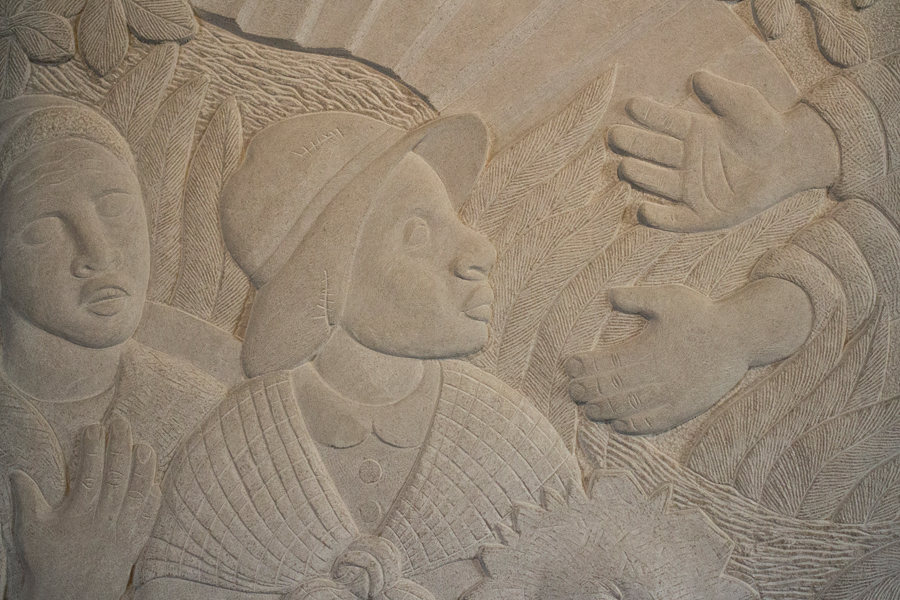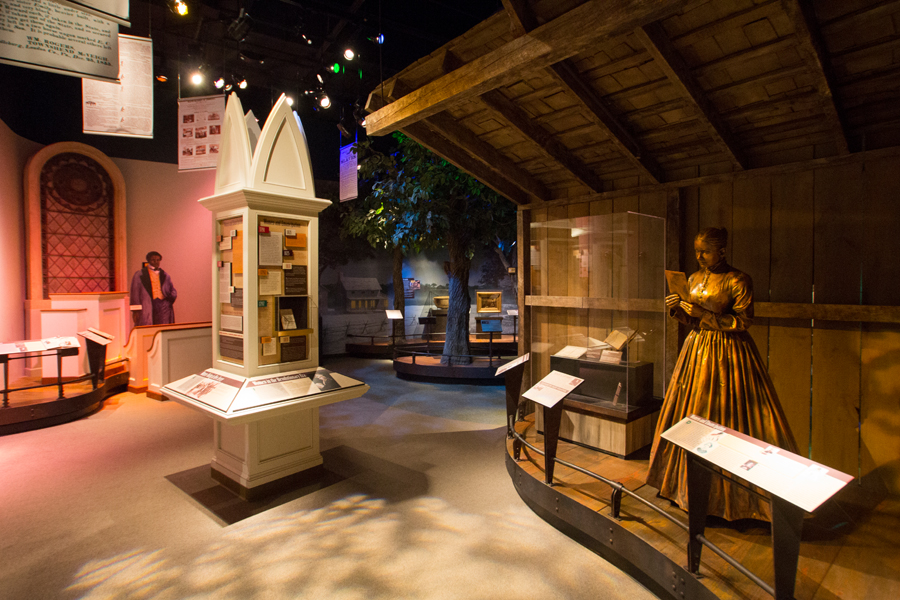Finding the Freedom Center
 |
| - Shackles on the floor of an actual slave pen that was relocated and rebuilt within the National Underground Railroad Freedom Center. |
A few months ago I was sitting in a downtown office with a consultant brought in to help the Cincinnati Convention & Visitors Bureau identify opportunities for marketing the city. We chatted about things appealing to tourists and out of town visitors. We both mentioned the usual things: the Reds, Bengals, Kings Island, the Zoo, craft beer, history, etc. - the kinds of things you can find similar versions of in any number of American cities. He was no stranger to traveling or to these types of tourism traits, but he noticed one thing that really stuck out about Cincinnati. After scribbling down some notes, he looked up and said:
"You know, one thing I noticed that can be found in Cincinnati that no other city has...
...a "freedom center."
 |
| - The Freedom Center as seen from Second St. |
It struck me that this visitor from out of town, who had traveled to cities all over the world pointed out the museum on the riverfront. I'll admit, in our entire discussion of Cincinnati's assets and history, I never once thought to bring up the National Underground Railroad Freedom Center. To be honest, at that point in my life I had never been through the museum.
 |
| - The Slave Pen. |
I found it interesting to hear an "outsider's" opinion, an opinion that hadn't been tainted by AM radio jocks that use the museum as political fodder. He was right though, the Freedom Center is something completely unique to Cincinnati and even though I never made the effort to go in its ten years of existence, maybe it was time to.
 |
| - The skyline of Cincinnati as seen from within the museum. |
I distinctly remember local radio host Bill Cunningham once referring to the institution as "the museum of white guilt," before he recommended it be turned into a jail or casino. That's an extreme opinion, one not out of character for a personality who consistently regurgitates outlandish statements to an army of listeners everyday on 700 WLW. No matter how provocative his statement was though, at its core it reflected the kinds of feelings that I think most Cincinnatians have towards the museum: a waste of tax dollars, an apology for the 2001 race riots, a "politically correct" monument to the well established evils of American slavery. Even Nathaniel Livingston, a vocal member of the local NAACP chapter, once referred to it as the "slave center." He claimed on his blog that "Some rich white folks with guilty consciences thought placing a "freedom" museum in Cincinnati would make them look and feel good, and trick Black people into thinking that the white man in Cincinnati loves them."
The museum has certainly been controversial from its funding to its mission. In the days leading up to writing this post, I asked people on Twitter, Facebook and Reddit what their opinion was of the museum. While admittedly unscientific, the responses all echoed similar themes: it's a burden on the taxpayers, a guilt trip, underutilized, depressing and too big. A small few, praised it. One of the recurring complaints was that the museum's location was bad. To me, that really stuck out.
 |
| - Visitors view a mural by artists Tyron Geter and Tom Feelings. |
The museum sits right on the city's riverfront, dead center and lined up with the dramatic entrance off of the iconic Roebling Suspension Bridge. For escaping slaves, crossing the Ohio River once symbolized that you had finally made it to freedom, to the Northern United States where slavery wasn't in practice. Cincinnati itself was a major stop on the "Underground Railroad," the vast network of secret routes to freedom. So why wouldn't a museum that symbolizes freedom fit perfectly on the spot where so many runaway slaves finally reached salvation?
In a lot of the responses, people admit that they had never been. Until recently, I hadn't visited myself. Now, having been through the entire museum, I think that most people miss its true message.
 |
| - The entrance to the exhibit "Invisible: Slavery Today." |
I can see where the misconception comes from, having the term "underground railroad" in your name seems to imply that the museum is solely about the history of slavery in America. It's not that simple, though. The museum states that it's goal is to "reveal stories of freedom’s heroes, from the era of the Underground Railroad to contemporary times, challenging and inspiring everyone to take courageous steps of freedom today."
 |
| - Pieces of the "slavery today" exhibit. |
The place isn't just about America's history with slavery, it's about much more. One of the museum's largest exhibits, "Slavery Today," is a contemporary look at how various forms of slavery still exist in the 21st century. It's interactive, compelling and sobering. The scope of the exhibit ranges from human trafficking in the local Ohio/Kentucky region to a global perspective on the sex trade and child labor conditions. When I asked about the Freedom Center on social media, this feature of the museum wasn't even mentioned. Frankly, it's the best reflection of the center's mission statement.
 |
| - The museum's eternal flame overlooking the nearby Roebling Suspension Bridge. |
There's other features of the museum as well that not many seem to cognizant of. For example, the museum's third floor offers a balcony with sweeping views of the iconic suspension bridge, Ohio River and Northern Kentucky shoreline. It also features an eternal flame akin to those found at the United States Holocaust Memorial Museum and at the gravesite of President John F. Kennedy.
 |
| - One of the exhibit's concludes with a tribute to the United States Constitution. |
And yes, the museum does focus a great deal of attention on the history of slavery in this country. Its exhibits follow the history of the slave trade from its roots in European colonization to its arrival on the shores of the "New World" to Southern segregation to modern day civil rights concerns. One walkthrough culminates with a look at the United States Constitution and the rights guaranteed by the founding fathers.
 |
| - A series of sculptures depicting the slave trade. |
Meanwhile, unique works of art adorn the museum's halls.
 |
| - One of artist Karen Heyl's "Flight to Freedom" limestone carvings. |
Outside, the theme of celebrating freedom is reflected again, this time in a piece of the Berlin Wall. When the wall fell, it was a symbol to the end of the Cold War and East Germany/Soviet Russia's oppression over its population.
 |
| - A piece of The Berlin Wall on display outside the museum. |

While the museum itself seems to hold pretty strong ratings and reviews on various trip planning websites, one review from Trip Advisor was particularly glaring. On January 6, 2012, one reviewer wrote:"This place goes out of their way to take you on a guilt trip down the memory lane of slavery." Remember the aforementioned radio host Bill Cunningham calling it "the museum of white guilt" and the NAACP blogger claiming that it was built by "rich white folks with guilty consciences?" "Guilt" seems to be the word everyone likes to attach to this place.
However, guilt isn't the museum's goal and if you walk away feeling guilty - then you weren't paying close enough attention.

One of the museum's main attractions is an actual slave pen that was located in Kentucky and rebuilt within the museum. Outside the pen are ledgers and receipts for slaves that document human beings as property in an inventory system, essentially an old school excel document. When you walk into the all wooden building, you'll find it's quiet, almost eerie. As seen in this post's first photograph, there's a solitary pair of shackles on the floor. It's an uneasy exhibit to enter and wrap your mind around, but at the same time it forces visitors to really confront the history of slavery.
To this day, the topic of slavery is still a touchy subject in the United States. It sparks uneasy conversations, political debates and is a blemish on the history of a nation that was founded and devoted to the idea that "all men are created equal" and free. It's a tough reality to face, but it's not something that should be ignored or skirted around. The National Underground Freedom Center tells the story of American slavery, but just as importantly tells the story of how a nation and world overcame it.
Not to mention, the museum focuses on how Cincinnati in particular was integral to that cause.
 |
| - A closeup shot of the ongoing quilt created by artist Aminah Brenda Lynn that documents slavery's history and present day effects. |
 |
| - A replica post indicating the distance to Cincinnati. |
I didn't walk out of the Freedom Center feeling guilty.
The Freedom Center is about history, about how America has changed and evolved, about continuing problems in the world and about how freedom is ultimately a right deserved by all people. Maybe it's time that people gave the museum a chance - not only the tourists visiting from out of town, but those who live here as well.
The museum's message and role is something we as Americans should take pride in, and the museum itself is an asset that we as Cincinnatians should hold in regard. Like the consultant I spoke with said...
...no other city has the Freedom Center.
 |
| - A visitor walks out of the museum's slave pen exhibit. |